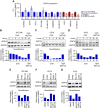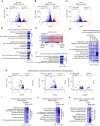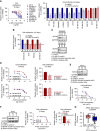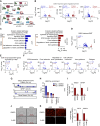p300 KAT Regulates SOX10 Stability and Function in Human Melanoma
- PMID: 38994683
- PMCID: PMC11293458
- DOI: 10.1158/2767-9764.CRC-24-0124
p300 KAT Regulates SOX10 Stability and Function in Human Melanoma
Abstract
SOX10 is a lineage-specific transcription factor critical for melanoma tumor growth; on the other hand, SOX10 loss-of-function drives the emergence of therapy-resistant, invasive melanoma phenotypes. A major challenge has been developing therapeutic strategies targeting SOX10's role in melanoma proliferation while preventing a concomitant increase in tumor cell invasion. In this study, we report that the lysine acetyltransferase (KAT) EP300 and SOX10 gene loci on chromosome 22 are frequently co-amplified in melanomas, including UV-associated and acral tumors. We further show that p300 KAT activity mediates SOX10 protein stability and that the p300 inhibitor A-485 downregulates SOX10 protein levels in melanoma cells via proteasome-mediated degradation. Additionally, A-485 potently inhibits proliferation of SOX10+ melanoma cells while decreasing invasion in AXLhigh/MITFlow melanoma cells through downregulation of metastasis-related genes. We conclude that the SOX10/p300 axis is critical to melanoma growth and invasion and that inhibition of p300 KAT activity through A-485 may be a worthwhile therapeutic approach for SOX10-reliant tumors.
Significance: The p300 KAT inhibitor A-485 blocks SOX10-dependent proliferation and SOX10-independent invasion in hard-to-treat melanoma cells.
©2024 The Authors; Published by the American Association for Cancer Research.
Conflict of interest statement
P.A. Cole is a cofounder of Acylin Therapeutics and reports personal fees from Acylin Therapeutics and AbbVie during the conduct of the study; personal fees from Scorpion Therapeutics and Nested Therapeutics outside the submitted work; and a patent for Methods and Compositions for Modulating P300/CBP Activity issued, licensed, and with royalties paid. R.M. Alani is a cofounder of Acylin Therapeutics and reports personal fees from Acylin Therapeutics prior to the conduct of this study. Her spouse, P.A. Cole, has disclosures as noted above. No disclosures were reported by the other authors.
Figures






Update of
-
p300 KAT regulates SOX10 stability and function in human melanoma.bioRxiv [Preprint]. 2024 Feb 23:2024.02.20.581224. doi: 10.1101/2024.02.20.581224. bioRxiv. 2024. Update in: Cancer Res Commun. 2024 Aug 1;4(8):1894-1907. doi: 10.1158/2767-9764.CRC-24-0124. PMID: 38469149 Free PMC article. Updated. Preprint.
Similar articles
-
p300 KAT regulates SOX10 stability and function in human melanoma.bioRxiv [Preprint]. 2024 Feb 23:2024.02.20.581224. doi: 10.1101/2024.02.20.581224. bioRxiv. 2024. Update in: Cancer Res Commun. 2024 Aug 1;4(8):1894-1907. doi: 10.1158/2767-9764.CRC-24-0124. PMID: 38469149 Free PMC article. Updated. Preprint.
-
Targeting Lineage-specific MITF Pathway in Human Melanoma Cell Lines by A-485, the Selective Small-molecule Inhibitor of p300/CBP.Mol Cancer Ther. 2018 Dec;17(12):2543-2550. doi: 10.1158/1535-7163.MCT-18-0511. Epub 2018 Sep 28. Mol Cancer Ther. 2018. PMID: 30266801
-
The myelin protein PMP2 is regulated by SOX10 and drives melanoma cell invasion.Pigment Cell Melanoma Res. 2019 May;32(3):424-434. doi: 10.1111/pcmr.12760. Epub 2018 Dec 21. Pigment Cell Melanoma Res. 2019. PMID: 30506895
-
ERK-mediated phosphorylation regulates SOX10 sumoylation and targets expression in mutant BRAF melanoma.Nat Commun. 2018 Jan 2;9(1):28. doi: 10.1038/s41467-017-02354-x. Nat Commun. 2018. PMID: 29295999 Free PMC article.
-
The miR-31-SOX10 axis regulates tumor growth and chemotherapy resistance of melanoma via PI3K/AKT pathway.Biochem Biophys Res Commun. 2018 Sep 18;503(4):2451-2458. doi: 10.1016/j.bbrc.2018.06.175. Epub 2018 Jul 3. Biochem Biophys Res Commun. 2018. PMID: 29969627
Cited by
-
Protein lactylation and immunotherapy in gliomas: A novel regulatory axis in tumor metabolism (Review).Int J Oncol. 2025 Jul;67(1):58. doi: 10.3892/ijo.2025.5764. Epub 2025 Jun 20. Int J Oncol. 2025. PMID: 40539457 Free PMC article. Review.
-
Pharmacological targeting of P300/CBP reveals EWS::FLI1-mediated senescence evasion in Ewing sarcoma.Mol Cancer. 2024 Oct 5;23(1):222. doi: 10.1186/s12943-024-02115-7. Mol Cancer. 2024. PMID: 39367409 Free PMC article.
-
Targeting lysine acetylation readers and writers.Nat Rev Drug Discov. 2025 Feb;24(2):112-133. doi: 10.1038/s41573-024-01080-6. Epub 2024 Nov 21. Nat Rev Drug Discov. 2025. PMID: 39572658 Review.
References
-
- Shakhova O, Zingg D, Schaefer SM, Hari L, Civenni G, Blunschi J, et al. . Sox10 promotes the formation and maintenance of giant congenital naevi and melanoma. Nat Cell Biol 2012;14:882–90. - PubMed
MeSH terms
Substances
Grants and funding
LinkOut - more resources
Full Text Sources
Medical
Molecular Biology Databases
Miscellaneous

